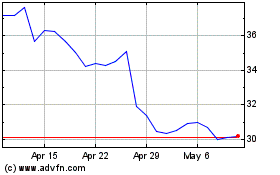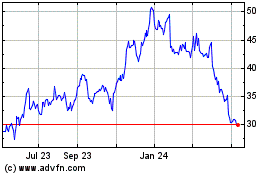Demand for PCs Powers Intel's Earnings -- WSJ
January 24 2020 - 3:02AM
Dow Jones News
All but one of its main business segments showed revenue growth
in the quarter
By Asa Fitch
This article is being republished as part of our daily
reproduction of WSJ.com articles that also appeared in the U.S.
print edition of The Wall Street Journal (January 24, 2020).
Intel Corp. posted strong fourth-quarter earnings that benefited
from an upswing in personal-computer shipments and robust demand
for chips to power data centers.
The chip maker Thursday said adjusted earnings per share in the
quarter rose to $1.52 from $1.28 in the year-prior period. Analysts
surveyed by FactSet were expecting $1.25 per share on an adjusted
basis. Sales in the period rose 8% to $20.21 billion, beating the
$19.23 billion analysts had expected.
The company's shares rose around 6% in after-hours trading.
Intel's results are only the latest sign technology companies
expect continued healthy demand at the start of this year despite
wider expectations for only a modest economic rebound this year.
Taiwan Semiconductor Manufacturing Co. Ltd., the world's largest
contract chip maker, last week forecast a 42% jump in sales for the
current quarter. European chip maker STMicroelectronics NV on
Thursday promised solid revenue growth for the year.
Intel benefited from bumper sales of high-margin products,
including its most advanced processors for data centers. That
demand helped drive earnings significantly higher than Wall Street
and Intel had projected, Chief Financial Officer George Davis said
in an interview. Intel's bottom line was also padded by gains on
investments, he said.
The Santa Clara, Calif.-based company gave an upbeat outlook for
the full year. Sales, it said, should reach about $73.5 billion.
Analysts are expecting sales to reach $70.98 billion. Intel posted
2019 annual sales of $71.97 billion, topping the $71 billion the
company forecast in October.
Intel's growth forecast for the year, Mr. Davis said, "really
reflects globally very strong demand for our data center products,
led by the cloud players."
The company has benefited recently from demand for
cloud-computing as companies migrate from owning servers to renting
data storage and processing horsepower. That has driven
cloud-computing vendors to build up big data centers, the
chip-hungry server farms where the data is stored.
Intel, the largest U.S. chip maker by revenue, also has enjoyed
stronger-than-expected demand for chips powering personal
computers. Vendors of those computers shipped large numbers of
devices running a newer version of Microsoft Corp.'s Windows
operating system before the software giant, this month, stopped
supporting the older Windows 7. PC shipments rose by 4.8% in the
quarter, according to International Data Corp. figures, helping
boost Intel's chip sales.
Chief Executive Bob Swan said the company was outperforming
revenue and earnings expectations in its long-term financial
plan.
All but one of Intel's main business segments showed revenue
increases in the fourth quarter. Its data-centers segment generated
$7.2 billion in October through December sales, up 19% compared
with the same period last year. The chip maker's PC division posted
modest growth. But the 2% rise in sales to $10 billion in the
quarter still topped the company's forecast for flat to slightly
lower sales. Only the small programmable solutions group, which
sells reprogrammable chips, saw sales slide 17% to $505
million.
Despite the better-than-expected quarter, Intel is facing
several challenges, including development difficulties with new
processors, chip supply shortages, loss of market share to its main
chip-making rival and turmoil from the U.S.-China trade tussle.
The company has been slow developing the tiniest transistors it
has ever made, measuring roughly 10 nanometers in length, or less
than 10 thousandths the width of a human hair. It is now ramping up
their mass-manufacturing. Those processors should help Intel keep
up in the arms race for faster computers, but bringing 10-nanometer
chip production to more manufacturing facilities is costly,
pressuring margins.
Intel also has been struggling with supplying all the processors
its customers want. Shortages last year prevented the company from
fully capitalizing on PC demand. The company in November sent an
unusual apology to PC manufacturers, saying it was making record
capital investments to boost production capacity, while also
increasing the use of contract chip manufacturers.
Even though Intel boosted processor production in the second
half of last year, Mr. Swan told analysts on a conference call that
"supply remains tight."
But that lag has allowed Advanced Micro Devices Inc., Intel's
main chip-making rival, to win market share. AMD also has been
rolling out new chips both for servers and PCs that outperformed
Intel's in some benchmarks and often cost less. Intel's market
share in chips for new laptops fell from almost 96% at the
beginning of 2018 to 82.5% late last year, according to Susquehanna
Financial Group research.
Like most American chip-makers, Intel also has had to grapple
with protracted U.S.-China trade tussle that has added tariffs and
red tape to dealings with customers and suppliers in the world's
second-largest economy. The U.S. and China last month agreed on a
phase-one trade deal that may provide relief by easing tariff
pressure on electronics that contain Intel's chips.
Intel's financial chief, Mr. Davis, said he was supportive of
the trade deal and any move that improved trade relations.
Write to Asa Fitch at asa.fitch@wsj.com
(END) Dow Jones Newswires
January 24, 2020 02:47 ET (07:47 GMT)
Copyright (c) 2020 Dow Jones & Company, Inc.
Intel (NASDAQ:INTC)
Historical Stock Chart
From Mar 2024 to Apr 2024

Intel (NASDAQ:INTC)
Historical Stock Chart
From Apr 2023 to Apr 2024
